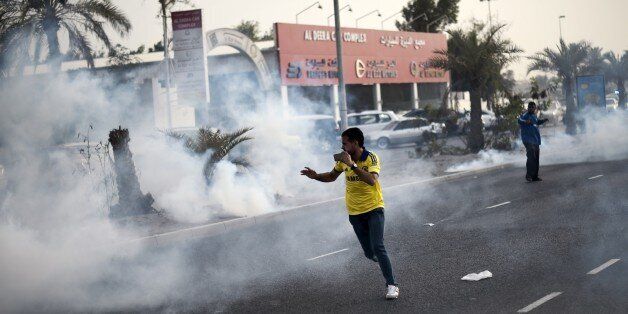
Tear gas is the biggest misnomer since Easy Listening. It sounds like something that might make your eyes bleary, right? Maybe force you to cry a bit.
As you might know, it's not like that at all. It sandpapers your retinas, roughly forces its way down your throat, grabs and scrapes and shreds your lungs. And that's not the worst of it. A Bahraini woman who was very active in protests there a couple of year ago explains it better: "It puts you in a state of panic, panic because your vision is compromised, panic because you're not sure how many more breaths you can take. At its worst you can't see at all, your eyes are completely swollen shut, and the more you try to breathe the worse it gets, the more you panic the faster you suffocate. It ought to be called Fear Gas," she says. "If you're exposed to it often you start suffocating in your sleep, it feels like it's burned a hole in your lungs and you suddenly wake up not being able to breathe. Milk helps a lot, but you need it next to the bed because you won't make it to the kitchen."
Tear gas, as academic Michael Crowley outlines in his authoritative new book Chemical Control, counts as a Riot Control Agent (RCA). There is also another class of weapon employing chemical agents, Incapacitating Chemical Agents (ICAs). Though different, what both classes of weapons have in common is that neither are properly regulated.
Governments say that non-lethal weapons like tear gas are a better alternative to dispersing rioters than shooting them with live ammunition, and on that they are right. But tear gas can be fatal for the very young or very old or those with respiratory problems, and the firing of the canisters themselves can be deadly. Tear gas is too readily used indiscriminately, or as collective punishment, and isn't always a safe option.
Protestors across the Middle East in 2011 were attacked by repressive security forces with tear gas cartridges stamped with Made in the USA, seriously damaging Washington's credibility and undermining the legitimacy of international arms controls. Crowley's book is bulging with explanations of the various chemicals contained in the weapons, and examples of how RCAs and ICAs are used by governments, armed opposition groups, private military companies and private security companies. He details how dozens of countries have allegedly used tear gas inappropriately between 2009 and 2013. With devastating understatement, Crowley concludes that the misuse of tear gas "appears to be widespread and serious."
What's needed, he says, is a process of Holistic Arms Control (HAC); new weapons being developed need to be scrutinized and methods of prohibiting or regulating their use drawn up. Existing controls need to be further refined too, from the Chemical Weapons Convention to the Biological and Toxin Weapon Convention to Human Rights Law.
Crowley rightly identifies the key role to be played by civil society by "fostering a 'culture of responsibility' in science...". Scientists should encourage whistleblowing and refuse to participate in RCA and ICA "programmes of concern." Health professionals have a special responsibility, he says. While the international medical community has made great progress over the last generation in forbidding collusion in torture and ill-treatment of detainees, there are currently "no widely accepted guidelines specifically determining the permissibility...of medical involvement..." in the development of RCAs and ICAs.
But the primary responsibility for the appropriate development and use of these weapons lies with governments, and they're obviously failing. The use of chemical weapons in Syria, and what Crowley calls the "creeping legitimization" of ICAs and the "erosion of the norm against the 'weaponization of toxicity'" is mostly met with a worldwide shrug.
It's unclear if those with the power to control the use of tear gas know what it really tastes like, how it makes you sob and retch and heave. But they do know it's routinely fired at peaceful protestors, sometimes as a reprisal against whole communities, and that in many places its use is out of control.
Holistic arms control could be the ultimate answer, but changing tear gas's name would be a start.
